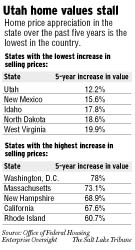Utah home values level off

|
By Lesley Mitchell
The Salt Lake Tribune
Once known for its soaring home values, Utah is now dead last on a list
ranking states by how much housing prices have increased over the past five
years.
Home prices in the state rose 12.2 percent from the first quarter
of 1998 to this year's first quarter, according to the Office of Federal
Housing Enterprise Oversight's House Price Index. The gain is the lowest
percentage increase among all 50 states and the District of Columbia, and
is well below the national average of 38 percent.
New Mexico had the second-lowest percentage increase in home values
over the five-year period, at 15.6 percent, followed by Idaho at 17.8 percent.
Washington, D.C., had the largest increase in home prices over that time
period, at 78 percent.
"Utah's housing prices began going up significantly at the beginning
of 1991 and were near the top of our list until about 1996," said Shelly
Dreiman, senior economist for the Office of Federal Housing Enterprise Oversight.
"It's been pretty low ever since then."
Utah also is last among all states in the increase in value for
the first quarter of this year compared with the same three months of 2002,
at just less than 2 percent. In addition, the state had the lowest increase
in value from the fourth quarter of 2002 to the first quarter of 2003, at
0.10 percent.
The Office of Federal Housing Enterprise Oversight, created to
oversee the safety and soundness of mortgage funds providers Fannie Mae and
Freddie Mac, tracks appreciation by measuring price changes of individual
properties as they are sold and refinanced over the years. Many economists
consider it to be one of the most accurate ways to measure housing price
appreciation.
Housing prices in Utah -- especially along the Wasatch Front
-- began to rise in the early 1990s as Utah's economy boomed and its population
surged.
Families from California and other states with higher home values
moved to Utah. As a result, demand for homes, especially higher-end homes,
began to climb.
"Up to that point we just hadn't had much appreciation," said
James Wood, interim director of the Bureau of Economic and Business Research
at the University of Utah. "Things began to change really quickly."
Salt Lake City suddenly was topping the list of cities nationwide
with red-hot real estate markets, allowing buyers who timed their purchases
right to walk away with tens of thousands of dollars of added equity after
just a few years of ownership.
At one point, homes sold within hours after they were placed on
the market, at the full asking price -- and sometimes for more as anxious
buyers tried to outdo each other.
Home prices kept skyrocketing until the mid-1990s, when appreciation
began to slow from double-digits to about 7 percent a year. By the late 1990s
appreciation had slowed to between 3 percent and 5 percent annually as the
national and state economy began to struggle, thousands of people lost their
jobs and fewer people began to move into the state.
At the same time, demand was decreasing as supply grew rapidly with the construction of thousands of new homes.
In recent months in some areas of the state, home prices have fallen,
while in other areas values have risen more slowly or not at all.
Over the long term, though, as Utah's economy improves and more
people move to Utah and more jobs are created, homeowners along the Wasatch
Front can expect to see appreciation in the range of 5 percent, predicted
Salt Lake City Realtor Jaren Davis.
But do not bank on that type of increase just yet, said Kelly
Matthews, executive vice president and economist for Wells Fargo Bank's Intermountain
region.
"If interest rates rise and Utah's economy doesn't begin to create
more jobs, we may get some further slippage in [home] values," he said. "It
could get worse before it gets better."
lesley@sltrib.com
|


